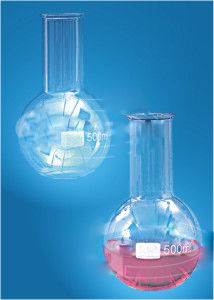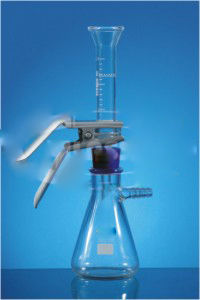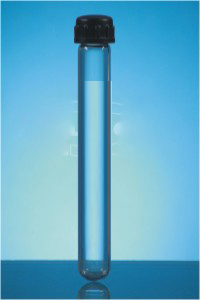Flask Flat Bottom
Flask Flat Bottom Specification
- Heating Capacity
- Suitable for direct heating
- Features
- Thermal Shock Resistance, Chemically Resistant, Easy to Clean
- Glass Type
- Borosilicate Glass
- Shape
- Flat Bottom
- Control Type
- Manual
- Temperature Resistance
- Up to 400C
- Accuracy
- Volumetric precision as per ASTM or ISO standards
- Type
- Laboratory Flask
- Dimension (L*W*H)
- Varies by capacity (e.g., 100ml: ~60x60x110mm)
- Equipment Type
- Flat Bottom Flask
- Equipment Materials
- Borosilicate Glass
- Voltage
- Not required
- Material
- Borosilicate Glass
- Capacity (Ltr)
- 50 ml, 100 ml, 250 ml, 500 ml, 1000 ml and others
About Flask Flat Bottom
| Flask Flat Bottom | ||||||||||||||||||||||||||||||||||||||||||||||||||
|
Precision Engineered for Laboratory Excellence
Each flask is manufactured from premium borosilicate glass, offering outstanding resistance to chemicals and thermal shock. Designed for repeated use, it meets rigorous ISO and ASTM standards to deliver consistent, accurate results in both academic and industrial laboratories.
Suitable for Diverse Applications
With volume gradations for estimation, the flat bottom design accommodates direct heating and a variety of experimental setups. The smooth, transparent finish aids visibility and ensures thorough cleaningperfect for research, quality control, and production labs.
FAQs of Flask Flat Bottom:
Q: How is the Flat Bottom Flask used in laboratory settings?
A: The flask is commonly utilized for mixing, heating, and storing liquids. Its flat bottom design provides stability during experiments, and the clear graduation markings assist with accurate volume estimation.Q: What materials are used to construct this flask, and why are they beneficial?
A: This flask is made from borosilicate glass, which offers excellent resistance to thermal shock, high temperatures up to 400C, and most chemicals, making it ideal for repeated laboratory use.Q: When should I choose a flat bottom flask over other types?
A: A flat bottom flask is appropriate when you require stability on lab surfaces and direct heating over a hot plate or burner. Its versatility makes it suitable for general lab work including titrations and heating reactions.Q: Where can this flask be utilized?
A: It is suitable for use in educational institutions, industrial laboratories, research facilities, and quality control labs, specifically designed for those requiring precision, reusability, and compliance with international standards.Q: What standards does the flask comply with, and how does that impact usage?
A: The flask conforms to ISO 1773 and ASTM E1403 standards, ensuring volumetric precision and safety, which is crucial for reproducible experimental results.Q: How do I clean and maintain the flask to ensure its longevity?
A: After each use, clean the flask with appropriate detergents and rinse with distilled water. Since it is autoclavable and chemically resistant, it can be sterilized without degrading the glass surface.Q: What are the key benefits of using a borosilicate glass flat bottom flask?
A: Key benefits include high thermal and chemical resistance, precise volume measurement, easy cleaning, and the ability to withstand direct heating and sterilization, making it a versatile tool for various laboratory tasks.

Price:
- 50
- 100
- 200
- 250
- 500
- 1000+
More Products in LABORATORY GLASSWARE Category
Funnel Filtration Holder
Type : Other, Funnel Filtration Holder
Equipment Materials : Borosilicate Glass, Stainless Steel Clamp
Glass Type : Borosilicate
Shape : Conical Funnel
Temperature Resistance : Up to 200C
Glass Stopcock, Straight
Type : Other, Glass Stopcock, Straight
Equipment Materials : Borosilicate Glass
Glass Type : Borosilicate glass 3.3
Shape : Straight
Temperature Resistance : High thermal resistance (up to 400C)
Application : For precise control of liquid or gas flow in laboratory glassware setups
Liebig Condensers
Type : Other, Liebig Condenser
Equipment Materials : Borosilicate Glass
Glass Type : Borosilicate
Shape : Cylindrical
Temperature Resistance : Up to 250C
Application : Laboratory use for distillation and condensation
Tubes, Culture, Media, Round Bottom
Type : Other, Test Tube
Equipment Materials : Plastic Glass
Glass Type : Borosilicate Glass
Shape : Round Bottom
Temperature Resistance : High resistance (suitable for autoclaving)
Application : Culture media transportation and storage
GST : 06ACOPS0805K1ZD
|
 |
SINGHLA SCIENTIFIC INDUSTRIES
All Rights Reserved.(Terms of Use) Developed and Managed by Infocom Network Private Limited. |


 Send Inquiry
Send Inquiry





